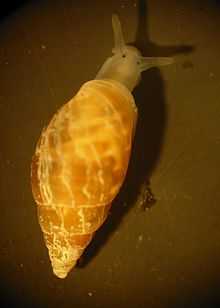Myosotella myosotis
| Myosotella myosotis | |
|---|---|
 | |
| live Myosotella myosotis | |
| Scientific classification | |
| Kingdom: | Animalia |
| Phylum: | Mollusca |
| Class: | Gastropoda |
| (unranked): | clade Heterobranchia clade Euthyneura |
| Superfamily: | Ellobioidea |
| Family: | Ellobiidae |
| Genus: | Myosotella |
| Species: | M. myosotis |
| Binomial name | |
| Myosotella myosotis (Draparnaud, 1801) | |
| Synonyms | |
|
see "List of Synonyms" | |
Myosotella myosotis, common name the mouse ear snail, is a European species of small, salt marsh snail, a terrestrial pulmonate gastropod mollusk in the family Ellobiidae.
Description
For terms see gastropod shell.
The shell is yellowish to brownish, smooth or with fine striation. It is shiny. There are 7-8 slightly convex whorls.The apertural margin is white and usually with a white layer at the parietal side. The parietalis is very strong and horizonal and often a small second parietalis is present. The columellaris is strong and the umbilicus is usually covered. The form denticulata has 3-6 short and thin folds (like drops) near the palatal margin at the inner lip.

Molecular phylogenetics
The complete nucleotide sequence of the mitochondrial genome of Myosotella myosotis has been available since 2008.[1]
Distribution
As a native snail this species is found in the following countries and islands:
As an exotic, this species is found on:
- The West Coast of North America
- The East Coast of North America
Description
The maximum recorded shell length is 12 mm.[2]
Habitat
This species lives right at sea level, and so therefore the minimum recorded depth for this species is 0 m, and the maximum recorded depth is 0 m.[2]
Synonyms
- Alexia (Auricula) myosotis (Draparnaud, 1801)
- Alexia (Auricula) myosotis var. hiriarti de Folin, 1889
- Alexia (Leuconia) micheli var. elongata Pallary, 1900
- Alexia (Leuconia) micheli var. incrassata Pallary, 1900
- Alexia algerica Bourguignat, 1864
- Alexia balearica Dohrn & Heynemann, 1862
- Alexia cossoni Bourguignat, 1887
- Alexia enhalia Bourguignat, 1887
- Alexia loweana Pfeiffer, 1866
- Alexia myosotis (Draparnaud, 1801)
- Alexia myosotis var. varicosa Fenaux, 1939
- Alexia obsoleta Pfeiffer, 1854
- Alexia parva Locard, 1893
- Alexia pechaudi Bourguignat, 1887
- Auricula (Alexia) meridionalis Brazier, 1877
- Auricula biasolettiana Küster, 1844
- Auricula botteriana Philippi, 1846
- Auricula ciliata Morelet, 1845
- Auricula dubia Cantraine, 1835
- Auricula kutschigiana Küster, 1844
- Auricula meridionalis Brazier, 1877
- Auricula microstoma Küster, 1844
- Auricula myosotis Draparnaud, 1801
- Auricula myosotis var. adriatica Küster, 1844
- Auricula myosotis var. elongata Küster, 1844
- Auricula tenella Menke, 1830
- Auricula veneta Martens, 1884
- Auricula venetiensis Megerle von Mühlfeld in Villa A. & G.B., 1841
- Auricula vespertina Morelet, 1860
- Auricula watsoni Wollaston, 1878
- Melampus gracilis Lowe, 1832
- Ovatella myosotis (Draparnaud, 1801)
- Ovatella myosotis salentina Palazzi & Curini Galletti, 1982
- Phytia letourneuxi var. tanousi Pallary, 1912
- Phytia myosotis (Draparnaud, 1801)
References
- ↑ Grande C., Templado J. & Zardoya R. (2008). "Evolution of gastropod mitochondrial genome arrangements". BMC Evolutionary Biology 2008, 8: 61. doi:10.1186/1471-2148-8-61
- ↑ 2.0 2.1 Welch J. J. (2010). "The "Island Rule" and Deep-Sea Gastropods: Re-Examining the Evidence". PLoS ONE 5(1): e8776. doi:10.1371/journal.pone.0008776.
External links
- Myosotella myosotis at Animalbase
- Info as an exotic: